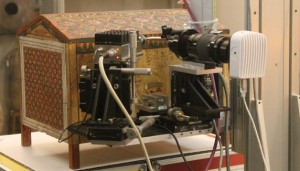 A large collection of artifacts from the Egyptian Museum of Turin was studied for the first time using analytical techniques. The study is performed within the ARKHA project. The collection is part of objects coming from one of the tombs discovered by Ernesto Schiapparelli’s Italian archaeological mission. In 1906 the archaeologist discovered the shaft of an underground tomb, containing the intact burial assemblage of two upper-class individuals, ‘the director of works’ Kha and his wife Merit. It was the richest and most complete non-royal burial assemblage ever discovered. Grave-goods include coffins tunics, beds, vases, cosmetics and prestigious luxury objects inscribed with royal names, which allowed to date his career between the reigns of Amenhotep II and Amenhotep III (1425-1353 BC). The grave-goods of Kha also include alabaster containers, ceramic vessels and jars for food, oil, powders and precious perfumes.
A large collection of artifacts from the Egyptian Museum of Turin was studied for the first time using analytical techniques. The study is performed within the ARKHA project. The collection is part of objects coming from one of the tombs discovered by Ernesto Schiapparelli’s Italian archaeological mission. In 1906 the archaeologist discovered the shaft of an underground tomb, containing the intact burial assemblage of two upper-class individuals, ‘the director of works’ Kha and his wife Merit. It was the richest and most complete non-royal burial assemblage ever discovered. Grave-goods include coffins tunics, beds, vases, cosmetics and prestigious luxury objects inscribed with royal names, which allowed to date his career between the reigns of Amenhotep II and Amenhotep III (1425-1353 BC). The grave-goods of Kha also include alabaster containers, ceramic vessels and jars for food, oil, powders and precious perfumes.
Painted caskets were studied by X-ray Fluorescence imaging. Results provide new clues on Egyptian painting techniques and the state of conservation of these ancient objects
Further Information
Researchers from NAST Centre applied for the first time non-invasive macro scan X-ray Fluorescence imaging (MA-XRF) to the Kha artifacts. The NAST Centre led an experimental team which included researchers from CNR Istituto per i Beni Archeologici e Monumentali (IBAM) of Catania and Istituto per i Processi Chimico Fisici (IPCF) of Messina, Museo Storico della Fisica e Centro Studi e Ricerche Enrico Fermi, the Museo delle Antichità Egizie di Torino and Soprintendenza Archeologia del Piemonte, Università degli Studi di Milano-Bicocca. The experimental apparatus was developed within a collaboration with CNR-IBAM and LANDIS laboratory of INFN-LNS. The new scanning methodology provided high-resolution images of the elemental distribution on the investigated paintings.
Preliminary results from the XRF scans of the Egyptian painted caskets coming for the Kha tomb already provided precious indications about the painting techniques applied, presence of different hands and their conservation status. The measurement campaign was performed in June 2016 at the Museo Egizio di Torino in the framework of a wider project aiming at the characterization of the intact Kha burial assemblage.
ARKHA (ARchaeology of the invisible: unveiling the grave goods of KHA) project. Objective of the study is to characterize the “Kha and Merit collection” by the integrated use of non invasive and non destructive chemical and physical techniques by the integrated use of light and neutron probes. ARKHA combines competences of scientists belonging to different disciplinary fields, i.e curators, restorations, Egyptologists, archeologists, chemists and physicists.
ARKHA project is a collaboration partnership among:
Università degli Studi di Roma Tor Vergata
Consiglio Nazionale delle Ricerche
Museo Egizio di Torino
Museo Storico della Fisica e Centro Studi e Ricerche “Enrico Fermi”
Soprintendenza Archeologia, Belle Arti e Paesaggio per la Città Metropolitana di Torino
Università degli Studi di Milano-Bicocca
Dr. Giulia Festa
Senior researcher at NAST Centre
University of Rome Tor Vergata,
giulia.festa@uniroma2.it
Related Links and Media
University of Tor Vergata
CNR Press Note
Media Gallery
Research date: July 2016


